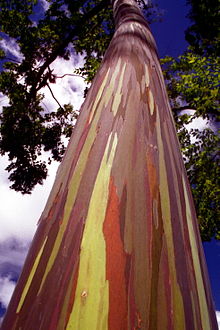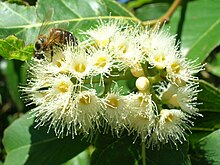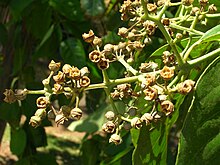Eucalyptus deglupta
| Eucalyptus deglupta | ||||||||||||
|---|---|---|---|---|---|---|---|---|---|---|---|---|

Eucalyptus deglupta |
||||||||||||
| Systematics | ||||||||||||
|
||||||||||||
| Scientific name | ||||||||||||
| Eucalyptus deglupta | ||||||||||||
| flower |
Eucalyptus deglupta because of the different color bark also rainbow tree called, is a plant of the genus eucalyptus ( Eucalyptus ). It is one of the few species of the genus that is distributed outside Australia and the only one that also occurs naturally north of the equator . Eucalyptus deglupta is one of the fastest growing tree species.
description
Vegetative characteristics
Eucalyptus deglupta grows as a very tall, evergreen tree , the trunk diameter of up to 200, exceptionally up to 300 centimeters and stature heights of mostly up to 60, in exceptional cases up to 80 meters. Depending on the site conditions, buttress roots can be 3 to 4 meters high .
The bark is smooth, brown to yellowish, green in peeled areas. The unique multi-colored bark is a striking feature of Eucalyptus deglupta . At cracks in the outer bark that occur annually, the bright green inner bark regularly appears, which then darkens and matures to blue, purple, orange and maroon tones.
The crown is conical in young trees, somewhat flattened with age. The branches are square, often with four leaf-shaped ridges on the edges (winged).
The opposite, almost opposite or alternate leaves arranged on the branches are divided into a petiole and a leaf blade. The petiole is 1 to 1.5 inches long. The normally horizontal, simple, entire leaf blade is ovoid to ovate-lanceolate with a length of 7 to 15, rarely up to 20 centimeters and a width of 4 to 7.5, rarely up to 10 centimeters with rounded to pointed or slightly pointed upper end. The bald leaf blade is slightly shiny on the top and lighter on the underside. There is pinnate veins . Stipules are missing.
Generative characteristics
The lateral or terminal total inflorescence is dold-like, contracted dichasium (so-called "conflorescence"), which consists of dold-like partial inflorescences, each containing three to seven flowers. The angular inflorescence stem is about 12 millimeters long. The flower stalk is about 5 millimeters long.
As is typical for the genus, the spherical or almost club-shaped flower bud is covered by a lid (operculum), hemispherical or conical in Eucalyptus deglupta , which is thrown off when it blossoms and leaves a scar. In Eucalyptus deglupta , as in all relatives, a double operculum is formed. The hermaphrodite flowers are radially symmetrical and white. There are different numbers, usually three to five, calyx tips and above a flower cup usually four to five inconspicuous petals , these can also be completely missing. There are numerous white stamens present. The ovary is subordinate.
The thin-walled capsule fruit is egg-shaped to club-shaped or spherical with a diameter of 3 to 5 millimeters. It is enclosed in the woody flower cup, which opens with three to four small fruit flaps when the seeds are ripe and contains numerous seeds. The tiny, brown seeds are flattened with a small, terminal wing.
Distribution and locations
Eucalyptus deglupta is the only type of eucalyptus that occurs naturally in the northern hemisphere . The natural range extends over New Britain , New Guinea , Seram , Sulawesi and Mindanao . It is one of the few species of eucalyptus that is naturally found outside of Australia (where it is not indigenous).
A decline is assumed in their natural range. Reasons are, in addition to the particular susceptibility to fire, preferred growth on flat alluvial land (also well suited for agriculture) and unsustainable timber harvest.
Eucalyptus deglupta thrives in humid tropical rainforests , with annual rainfall of at least 2,500, sometimes more than 5,000 millimeters, it is the only type of eucalyptus that occurs naturally in tropical rainforests . It thrives best at altitudes below 150 meters, on alluvial soils , but occurs occasionally in mountains up to altitudes of 2000 meters. In optimal locations, it is one of the fastest growing tree species on earth.
Systematics
The first mention of this species as Arbor versicolor by the botanist Georg Eberhard Rumpf comes from the year 1743, from a specimen probably collected on Seram in 1668. The formal first description of Eucalyptus deglupta , which meets today's taxonomic standards, was made by Carl Ludwig Blume in 1849; it was based on a (non-blooming) specimen collected on Sulawesi in the herbarium of Kaspar Georg Karl Reinwardt . Synonyms for Eucalyptus deglupta Blume are: Eucalyptus multiflora Gray, Eucalyptus binacag Elmer, Eucalyptus schlechteri Diels, Eucalyptus naudiniana F.Muell.
Eucalyptus deglupta is placed within the genus Eucalyptus with five other tropical species in a subgenus Telocalyptus (considered by other authors as the subgenus Minutifructus ). However, genetic studies indicate that this sub-genus is not a natural unit, so the species belong to the (most species-rich) sub-genus Symphyomyrtus . This is also supported by the fact that the species forms hybrids with other species of the subgenus Symphyomyrtus .
Uses
Eucalyptus deglupta is also grown in plantations , mainly for wood fiber in the manufacture of paper . It is mainly used in the Philippines for paper production. Eucalyptus deglupta is one of the five most important eucalyptus species for forestry worldwide . Hybrids are also grown .
Eucalyptus deglupta is used as an ornamental plant in tropical and subtropical gardens and parks. It's not hardy .
Wood
The heartwood is red-brown and often indistinctly set off from the white to pink sapwood . The wood contains 44 to 51% cellulose , 29 to 30% lignin , 14 to 19% pentosans , the ash content is 0.6 to 1.2%. The dry wood is easy to work with by hand and by machine, but has a tendency to crack, especially when drilling. It's not very permanent and is prone to termites .
Common names
Common names are Bagras (Philippines), Mindanao gum (Australia), Komo or Kamarere (New Guinea).
Individual evidence
- ↑ a b c d e f g h i M. Brink, 2011: Eucalyptus deglupta Blume In: M. Brink, EG Achigan-Dako (editor). PROTA = Plant Resources of Tropical Africa , Wageningen, Netherlands. ( Memento of the original from October 7, 2015 in the Internet Archive ) Info: The archive link was inserted automatically and has not yet been checked. Please check the original and archive link according to the instructions and then remove this notice. accessed on October 6, 2015
- ↑ a b c d e FAO Databook on Endangered Tree and Shrub Species and Provenances. FAO Forestry Paper Vol. 77. ISBN 9789251025222 . Pages 262-270.
- ↑ a b c John Davidson: Eucalyptus deglupta. The Forrester (Publication of the Institute of Forresters of Australia) August 2015: 28-31.
- ^ A b Johan Davidson: Ecological aspects of Eucalyptus Platations. FAO, Forestry Group, Proceedings. Regional expert consultation on eucalyptus. Volume I. online
- ↑ SP Whittock, DA Steane, RE Vaillancourt, BM Potts, 2003: Molecular evidence shows did the tropical boxes (Eucalyptus subgenus minutifructus) are over-ranked. In: Transactions of the Royal Society of South Australia , Volume 1217, 1, pp. 27-32.
- ↑ Wood Technical Fact Sheet of the USDA Forest Service .
Web links
- CABI = Invasive Species Compendium. Datasheet: Eucalyptus deglupta (kamarere) accessed on October 6, 2015.



